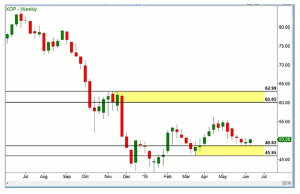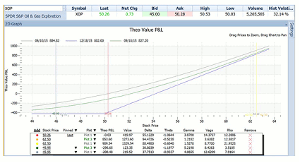Options instructor Russ Allen, of Online Trading Academy, details how software tools can now calculate the effects of actual change in stock price, change in expectation for future stock price change, and passage of time, allowing option traders to visualize their results at a glance.
In the last article I wrote about using the information in the option chain. Some of the most important information is contained in the Greeks, the variables that describe how options react to various events. As I wrote then, the most important events in an option’s life and the variables that measure the reaction of options to those events are:
- Actual changes in stock price. Measured by Delta.
- Change in expectations for future stock price change. Measured by Vega.
- Passage of time. Measured by Theta.
I noted that there are software tools that calculate these effects for us and allow us to visualize their results at a glance. Today we’ll look at those.
First, we have to realize that to trade options profitably we have to have an opinion about what the price of a stock is most likely to do. Our opinion might be that the stock will go up, that it will go down, or that it will stay in a range for a while.
Then we select an options strategy, from the dozens that are available, that will pay us if we are right in our opinion. Depending on how confident we are in that opinion, we can pick a strategy that will pay off big, but only if the stock proves us right; or we can pick one that has a more modest payoff, but will pay us even if we are a little bit wrong.
Before we commit money to our trade, we have to estimate how much we stand to make if we win versus how much we stand to lose. This is a bit more involved with options than it is with stocks. That’s why we need the tools to help us. Here’s an example.
On June 10, 2015, the chart of XOP, the exchange-traded fund that invests in the stock of oil and gas exploration companies, looked like this:
Reacting to the price of oil, XOP had been grinding higher since mid-January after a dramatic drop in the second half of 2014. It had pulled back to a demand zone formed in March, which appeared to have a good chance of holding. If so, it might reach the $62.50 area within a few months. On the other hand, we would consider this emerging uptrend to have failed if XOP dropped below the low of its last bounce, at $45.95.
A simple option strategy would be to buy call options on XOP. Calls go up in value when the underlying stock does but cost far less. The catch is that call options expire at some fixed date so the move we expect has to happen before that.
On June 10, with XOP at $50.26, we could have bought the $50 call options with a December 2015 expiration date for $4.20 per share ($420 per hundred-share option contract). These gave us the right to buy XOP at $50 at any time until the third Friday in December.
Before committing real money to this trade, we needed to know how much we could make if we were right, and how much we could lose if we were wrong. If we do it right, the amount we would stand to lose would be considerably less than the $420 cost of a contract.
Below is an option payoff graph for this trade:
This graph shows what the profit or loss would be on the trade, assuming that we paid the $420 current price for the $50 calls, at any price of the stock. Profit/loss is on the vertical axis labeled Theo Value P&L. Stock prices are on the horizontal axis. The graph incorporates the effects measured by all of the Greeks and translates them into a visual form.
This graph and its associated table tell us everything we need to know about what could happen to this trade. It shields us from some very involved calculations and boils down the whole lot into answers to these simple questions: How much can I make if the stock does what I expect? How much can I lose if it doesn’t?
In this example, we are looking for a target price of $62.50, and we expect that it could take about three months to get there. The second row in the table says that if XOP were to be at a price of $62.50 three months from now, the Theo P&L would be $853.60 and that the Value of the option would be $1273.60. The fourth row in the table says that if XOP were to be at a price of $45.95 three months from now, the Theo P&L would be $-295.65 and that the Value of the option would be $123.35.
So there we have it. We could make $853.60 if XOP does what we expect; or we could lose $295.65 if instead XOP drops to the point where we would abandon the trade. It would have taken us a great deal of time to work out what the option price at some future date and stock price would be by applying each of the Greeks separately. That would be possible but not worth the trouble and the trade would be gone by the time we figured it out. With the ability to draw this graph, we can do it in seconds.
There is more that this chart tells us…but that is a story for another day.
By Russ Allen, Instructor, Online Trading Academy























